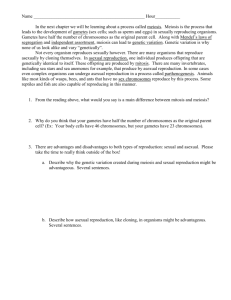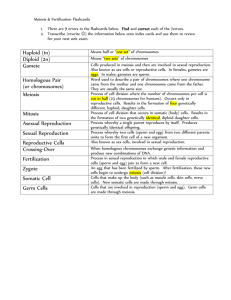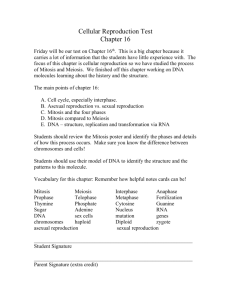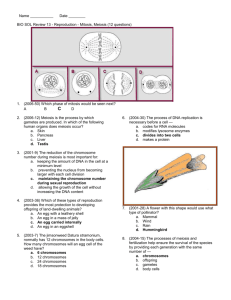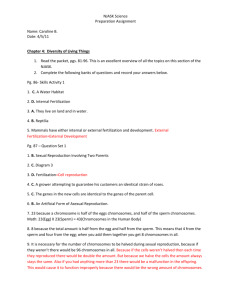Reproduction and Reproductive Technologies Test
advertisement
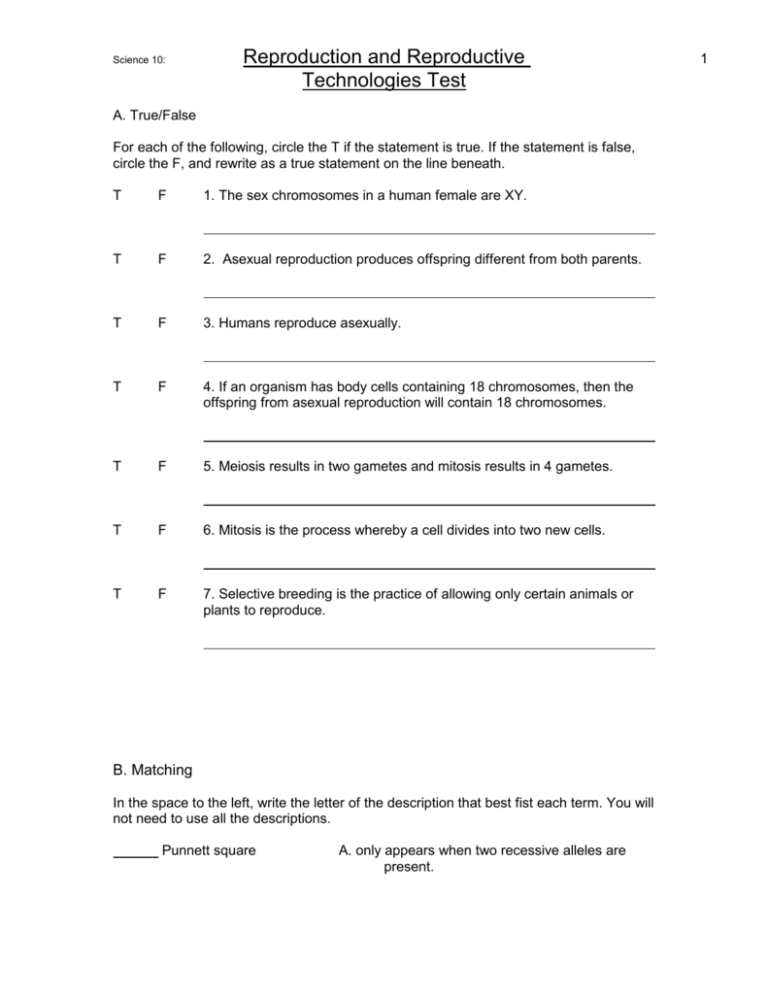
Science 10: Reproduction and Reproductive Technologies Test A. True/False For each of the following, circle the T if the statement is true. If the statement is false, circle the F, and rewrite as a true statement on the line beneath. T F 1. The sex chromosomes in a human female are XY. T F 2. Asexual reproduction produces offspring different from both parents. T F 3. Humans reproduce asexually. T F 4. If an organism has body cells containing 18 chromosomes, then the offspring from asexual reproduction will contain 18 chromosomes. T F 5. Meiosis results in two gametes and mitosis results in 4 gametes. T F 6. Mitosis is the process whereby a cell divides into two new cells. T F 7. Selective breeding is the practice of allowing only certain animals or plants to reproduce. B. Matching In the space to the left, write the letter of the description that best fist each term. You will not need to use all the descriptions. Punnett square A. only appears when two recessive alleles are present. 1 Science 10: Reproduction and Reproductive Technologies Test homozygous dominant trait incomplete dominance heterozygous recessive trait gene sex-linked gene heredity sexual reproduction asexual reproduction chromosome meiosis gamete zygote mitosis fertilization B. trait that is suppressed when two unlike alleles are together C. part of a chromosome that determines a trait D. a gene tat is on the X or Y chromosome E. having two unlike alleles for the same gene F. helps to describe ways in which genes may combine G. transmission of traits from parent to offspring H. the separation of paired chromatids into two identical sets at opposite ends of the cell. I. recognizable characteristic or feature J. having two like alleles for the same trait K. blending of trait forms L. special cell for reproduction M. the combining of a male and female reproductive cell, and the fusing of their nuclei, to form a new diploid cell N. the production of offspring from a single parent O. a group of cells that do not reproduce properly P. the process that produces specialized reproductive cells containing only half the chromosomes of the parent Q. the new cell that results from fertilization of an egg. R. a structure in the nucleus that contains the genes. S. reproduction that requires two parents 2 Science 10: Reproduction and Reproductive Technologies Test Multiple Choice In each of the following questions, circle the letter of the best answer. Circle only one answer in each question. 1. New body cells are produced by the process of a. reproduction b. meiosis c. fertilization d. mitosis 2. Mitosis occurs when a. a body cell makes an exact duplicate of itself b. gametes are produced in the ovaries or testes c. sperm and eggs are produced d. a zygote is produced 3. Reproduction by a single parent is called a. asexual reproduction b. trans-sexual reproduction c. sexual reproduction d. homosexual reproduction 4. A cell produced by mitosis has a. twice as many chromosomes as the parent cell b. half as many chromosomes as the parent cell c. the same number of chromosomes as the parent cell d. no chromosomes at all 5. Asexual reproduction is a process that requires a. only one parent, and produces many offspring that are all different b. only one parent, and produces offspring that are very like the parent c. two parents, and produces offspring that are very like the parents d. two parents, and produces many offspring that are all different. 6. Which of the following is an advantage of sexual reproduction over asexual reproduction? a. it requires two parents b. it produces fewer offspring c. it produces greater variety in the offspring d. the offspring are usually a mix of make and female. 7. Sexual reproduction differs from asexual reproduction in that it involves a. only one parent b. offspring with identical characteristics c. two parents d. only one parent with offspring with different characteristics 8. If the body cells of an organism each contain 24 chromosomes, how many chromosomes would there be in its gametes? a. 6 b. 24 c. 12 d. 48 9. The human embryo normally develops in the a. uterus b. fallopian tubes c. ovary d. abdominal cavity 10. Meiosis occurs when a. skin cells are replaced as they wear away b. a sperm penetrates an egg to form a new organism c. asexual reproduction takes place d. sperm and eggs are produced in the testes or ovaries 11. Fertilization occurs when a. new red blood cells are made to replace old ones that have died b. sperm and eggs are produced in the testes or ovaries c. an amoeba pulls itself apart to form two new amoebas d. a sperm penetrates an egg to make the first cell of a new organism 12. A difference between mitosis and meiosis is that a. mitosis occurs only in specialized organs and meiosis occurs in all organs b. mitosis involves one cell division and meiosis involves two cell divisions c. the cells produced by mitosis have one-half the number of chromosomes as the cells produced by meiosis d. centromeres split once in mitosis but twice in meiosis Use the following diagram to answer the questions below. 13. The phase of mitosis of this cell is a. prophase b. anaphase c. telophase d. metaphase 14. During the next phase a. four gametes will form b. the nucleus will form again c. centromeres will separate d. chromosomes will become more distinct 3 Science 10: Reproduction and Reproductive Technologies Test 4 15. Each daughter cell will contain a. 2 single stranded chromosomes (chromatids) b. 2 double stranded chromosomes (with their centromeres) c. 4 single stranded chromosomes (chromatids) d. 4 double stranded chromosomes ( with their centromeres) Questions 23-25 refer to the pea cross below: Use either FOIL or a Punnet square to answer the questions. A homozygous green plant is crossed with a homozygous white pea plant. All the offspring of the cross were white. 16. Chromosomes will be replicated during the next a. interphase b. telophase c. prophase d. metaphase 21. In this case, the allele for the color white must be: a. continuous c. dominant b. recessive d. sex-linked 17. During mitosis, chromosomes are first seen as pairs of chromatids during a. anaphase b. metaphase c. prophase d. telophase 18. If a body cell of a certain organism contains 18 chromosomes, the number of chromosomes in a sperm cell produced by this organism is a. 72 b. 36 c. 18 d. 9 19. Meiosis produces a. zygotes c. body cells b. gametes d. homologues 20. How is the sex of human offspring determined? a. The egg from the mother contains either an X or a Y chromosome. b. The egg from the mother contains two X chromosomes. c. The sperm from the father contains two X chromosomes. d. The sperm from the father contains either an X or a Y chromosome. 22. With respect to colour, all of the offspring of this cross must have been: a. homozygous c. dominant b. heterozygous d. recessive 23. The PHENOTYPIC ratio of the F2 (second generation) cross would be: a. 1:1 white:green b. 3:1 white:green c. 2:1 white:green d. all white 24. The color of a rabbits coat is controlled by a gene that has a different allele for brown, black, blond, white, red, and gray. This an example of a trait which is controlled by: a. codominance b. multiple genes c. multiple alleles d. sex-linkage 25. A certain flower can be white, purple, red, white with purple spots ,or red with white spots. The trait is controlled by the gene called C(color) and S (spots). This is an example of a trait which is controlled by : a. codominance b. multiple genes c. multiple alleles d. sex-linkage Use the following diagrams of meiosis, shown out of order, to answer questions 26 and 27: 1. 2. 3. 27. The number of homologous pairs of chromosomes in this cell is a. 3 b. 6 c. 12 4. d. 24 28. The correct sequence of stages for the portion of the process shown above is: a. 3-4-1-2 b. 2-3-1-4 c. 1-3-4-2 d. 1-3-2-4 Science 10: Reproduction and Reproductive Technologies Test D. Short Answer 1. What is the possible genotype and phenotype of the offspring produced by a heterozygous dominant orange plant crossed with a homozygous recessive yellow plant? (5 marks) 2. Explain the difference between artificial insemination and in vitro fertilization (test-tube babies). (2 marks) 3. Explain how a domestic cat could be a surrogate mother to an endangered species called the Indian desert cat. 4. Use the Genetic Disease that you presented to the class to answer the following questions: (3 marks) Genetic Disease: a. What is the genetic origin of the disease.? b. What are the symptoms of the disease? c. What are the treatments for this disease? 5. What are three purposes of the seminal fluid? (3 marks) 5 Science 10: Reproduction and Reproductive Technologies Test 6. What is the “PAP” test for? (1 mark) 7. Why is the complicated process of mitosis so important? (2 marks) 8. Why is the complicated process of meiosis so important? (2 marks) E. Completion Read carefully and fill in the sentences in the paragraph on the left. choose your terms form the following list: egg, fertilization, gamete, meiosis, mitosis, ovaries, sperm, testes, zygote Write your answers beside the appropriate letter on the right. If a letter appears more than once in the paragraph, it refers to the same word each time. In human sexual reproduction, the parents each donate cells called a (a) . The female (a) is the (b) cell, and is produced in the (c) . The males (a) is the (d) cell, and is produced in the (e) . When these (a) cells combine during the process of (f) , a new cell is formed. This new cell, called the (g) , will grow and divide by the process of (h) to form the new offspring. a. b. c. d. e. f. g. h. 6


